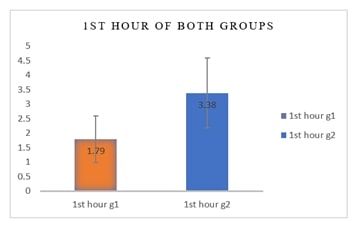References:
[1]. Macario, A., Weinger, M., Carney, S., et al. 1999, Which Clinical Anesthesia Outcomes are Necessary to Avoid. The Perspective of Patients. Anesth Analg, 89(3), 652–658 https://doi.org/10.1097/00000539-199909000-00022
[2]. Errando, C. L., Sigl, J. C., Robles, M., Calabuig, E., Garc´ıa, J., Arocas, F., et al., 2008, Awareness with Recall During General Anaesthesia: A Prospective Observational Evaluation of 4001 Patients. Br J Anaesth.101, 178–85 Doi: 10.1093/bja/aen144
[3]. Messner, M., Beese, U., Romstock, J., Dinkel, M., Tschaikowsky, K., 2003, The Bispectral Index Declines During Neuromuscular Block in Fully Awake Persons. Anesthesia and Analgesia, 97, 488-491 Doi: 10.1213/01.ANE.0000072741.78244.C0
[4]. Schuller, P. J., Newell, S., Strickland, P. A., Barry, J. J., 2015, Response of Bispectral Index to Neuromuscular Block in Awake Volunteers. British Journal of Anaesthesia, 115(Suppl. 1), i95-i103, Doi: 10.1093/bja/aev072
[5]. Punjasawadwong, Y., Boonjeungmonkol, N., Phongchiewboon, A., 2014, Bispectral Index for Improving Anaesthetic Delivery and Postoperative Recovery. Cochrane Database Syst., Rev., 6, CD003843. Doi: 10.1002/14651858.CD003843.pub3.
[6]. Sebel, P. S., Bowdle, T. A., Ghoneim, M. M., et al., 2004, The Incidence of Awareness During Anesthesia: A Multicenter United States Study. Anesth Analg., 99(3), 833–839, Doi: 10.1213/01.ANE.0000130261.90896.6C.
[7]. Sandin, R. H., Enlund, G., Samuelsson, P., Lennmarken, C., 2000, Awareness during Anaesthesia: A Prospective Case Study. Lancet, 355(9205), 707–711 Doi: 10.1016/S0140-6736(99)11010-9
[8]. Mashour, G. A., Kent, C., Picton, P., Ramachandran, S. H., Tremper K. K., Turner, C. R., Shanks, A., Avidan, M. S. 2013, Assessment of İntraoperative Awareness with Explicit Recall: A Comparison of 2 Methods. Anesthesia and Analgesia, 116 (4): 889-891. https://doi.org/10.1213/ANE.0b013e318281e9ad
[9]. Errando, C. L., Sigl, J. C., Robles, M., Calabuig, E., Garcia, J., Arocas, F.,Higueras, R., Del Rosario, E., Lopez, D., Peiro, C. M., Soriano, J. L., Chaves, S., Gil, F., Garcia-Aguado, R., 2008, Awareness with Recall During General Anaesthesia: A Prospective Observational Evaluation of 4001 Patients. British Journal of Anaesthesia, 101(2), 178-185. https://doi.org/10.1093/bja/aen144
[10]. Singla, D., Mangla, M., 2017, Incidence of Awareness With Recall under General Anesthesia in Rural India: An Observational Study. Anesthesia Essays and Research, 11 (2): 489-494. https://doi.org/10.4103/aer.AER_44_17
[11]. Pandit, J. J., Andrade, J., Bogod, D. G., et al., 2014. 5th National Audit Project (NAP5) on Accidental Awareness During General Anaesthesia: Summary of Main Findings and Risk Factors. British Journal of Anaesthesia 113, 549–59, Doi: 10.1093/bja/aeu313
[12]. Flaishon, R., Windsor, A., Sigl, J., Sebel, P.S. 1997, Recovery of Consciousness After Thiopental or Propofol. Bispectral Index and Isolated Forearm Technique. Anesthesiology, 86(3), 613–619, Doi: 10.1097/00000542-199703000-00013
[13]. Glass, P. S., Bloom, M., Kearse, L., Rosow, C., Sebel, P., Manberg, P., 1997, Bispectral Analysis Measures Sedation and Memory Effects of Propofol, Midazolam, Isoflurane, and Alfentanil in Healthy Volunteers. Anesthesiology, 86(4), 836–847, Doi: 10.1097/00000542-199704000-00014
[14]. Tammisto, T., Tigerstedt I., 1997, The Need for Halothane Supplementation of N2O-O2-Relaxant Anaesthesia in Chronic Alcoholics. Acta Anaesthesiol Scand, 21(1), 17-23, Doi:10.1111/j.1399-6576.1977.tb01187.x
[15]. Absalom, A. R., Green, D., 2014, NAP5: the Tip of the Iceberg, or All We Need to Know? British Journal of Anaesthesia, 113, 527–30, https://doi.org/10.1093/bja/aeu349
[16]. Pandit, J. J., Andrade, J., Bogod, D. G., et al., (2014): 5th National Audit Project (NAP5) on Accidental Awareness during General Anaesthesia: Summary of Main Findings and Risk Factors. British Journal of Anaesthesia,113, 549–59 Doi: 10.1093/bja/aeu313
[17]. Myles, P.S., Leslie, K., McNeil, J., Forbes, A., Chan, M. T., 2004, Bispectral Index Monitoring to Prevent Awareness during Anaesthesia: The B-Aware Randomised Controlled trial. Lancet, 363 (9423), 1757–63 Doi: 10.1016/S0140-6736(04)16300-9
[18]. Avidan, M. S., Zhang, L., Burnside, B. A., Finkel, K. J., et al., 2008, Anesthesia Awareness and the Bispectral Index. New England Journal of Medicine, 358 (11), 1097–108 Doi: 10.1056/NEJMoa0707361
[19]. Avidan, M. S., Jacobsohn, E., Glick, D., et al., 2011, Prevention of Intraoperative Awareness In A High-Risk Surgical Population. New England Journal of Medicine, 365, 591–600, Doi: 10.1056/NEJMoa1100403
[20]. Mashour, G. A., Shanks, A., Tremper, K. K., et al., 2012, Prevention of Intraoperative Awareness with Explicit Recall in an Unselected Surgical Population: A Randomized Comparative Effectiveness Trial. Anesthesiology,117, 717–25, Doi: 10.1097/ALN.0b013e31826904a6
[21]. Schacter, D. L., 1987, Implicit Expressions of Memory in Organic Amnesia: Learning of New Facts and Associations. Hum Neurobiol, 6:107–18.


